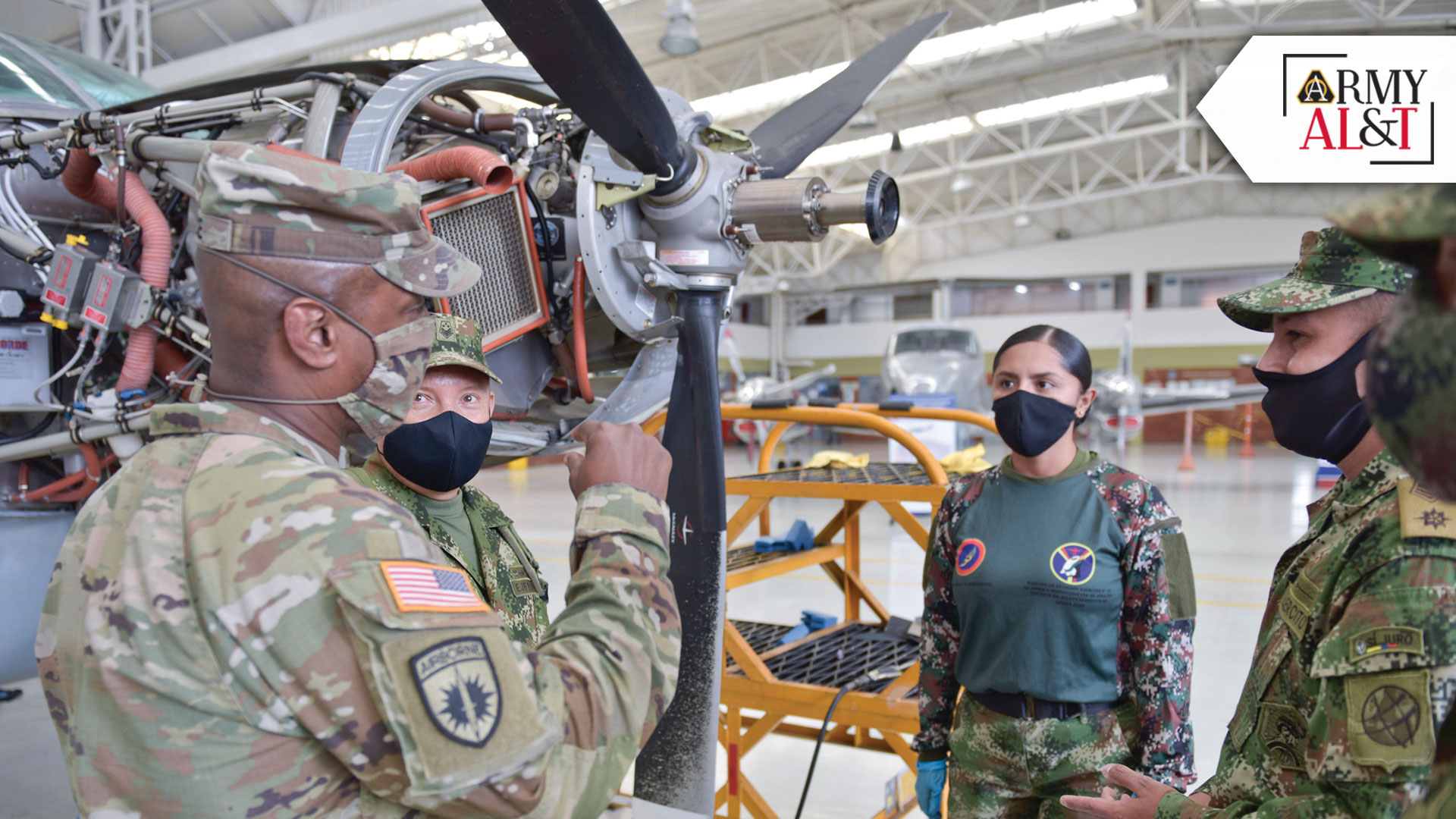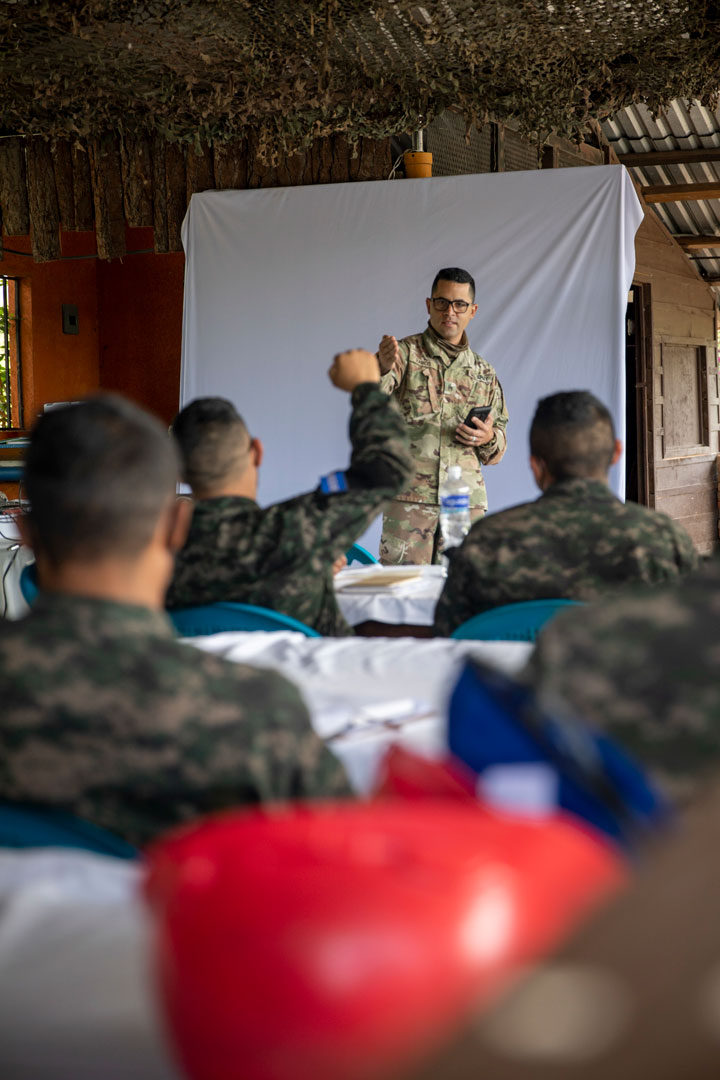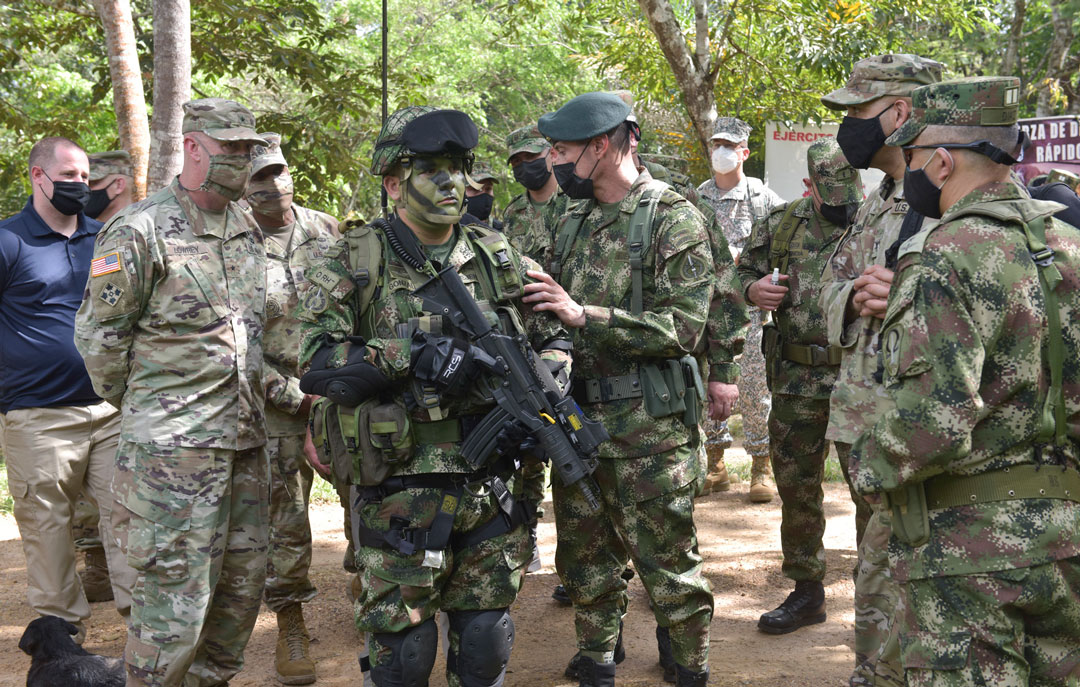
SHARED GOALS: Command Sgt. Maj. Sean Rice, left, senior enlisted advisor at U.S. Army Security Assistance Command (USASAC), talks with soldiers assigned to the aviation maintenance unit of the Colombian Army base in Tolemaida, Colombia, in April. Rice and other USASAC leaders visited several sites to see the impact of U.S. security assistance and foreign military sales, in support of the Colombian military in defending their country from narcotic and terrorist threats. (Photo by Richard Bumgardner, USASAC)
An all-of-Army approach to building foreign capability advances U.S. coalition readiness.
by Robert Maginnis and Michael Prater
Until 2018, a significant shortfall in the Army’s international engagement strategy was a self-imposed division of labor between conventional forces’ exercise-centric security cooperation and the materiel-focused security assistance enterprise, which resulted in less than optimal outcomes. Congress helped the U.S. Army rethink this synergy of effort by issuing new guidance via the Fiscal Year 2017 National Defense Authorization Act, which promises to result in better designed capability that meets U.S. and partner shared security goals.
DIVISION OF LABOR
The Army’s operational forces conducted security cooperation through troop exercises, information sharing and key leader engagements for decades. Meanwhile, the Army security assistance enterprise worked out of the limelight, remaining mostly materiel-focused and tethered to the State Department’s 22 U.S. Code, Subchapter II—Foreign Military Sales authorizations. The bifurcated foreign engagement activities infrequently overlapped, missing the Army’s true potential for helping prepare foreign partners to defend themselves as well as strengthen U.S. Army units for coalition operations and reach the aspirational outcome of robust interoperability—a stretch goal for Army commanders and our best foreign partners.
The Army’s division of security cooperation labor is the result of a decision made decades ago to split into two international engagement entities previously housed under the deputy undersecretary of the Army for international affairs.
The first entity in this division of labor is the Army secretariat represented by the deputy assistant secretary of the Army for defense export and cooperation (DASA (DE&C)) under the authority of the assistant secretary of the Army for acquisition, logistics and technology. DASA (DE&C) oversees the transfer of materiel, engineering activities and related training for foreign partners such as servicing foreign military sales cases and armaments cooperation agreements to leverage foreign technologies and capabilities that support Army readiness, modernization and interoperability goals.
The balance of international engagement activities was assumed by the Army’s chief of operations, the assistant chief of staff G-3/5/7, which oversees the day-to-day maneuver-related engagements with foreign partners. That partition of effort can result in conflicting messages to foreign partners and less than optimal outcomes for the Army’s contribution to DOD’s strategic goals of building partner capabilities and preparing for global coalition operations.
REDEFINING EFFORTS
Fortunately, those too often disjointed outcomes are now collapsing into a far more synergistic endeavor thanks to the National Defense Authorization Act of 2017, and in particular the codification of Title 10, Chapter 16, Security Cooperation.
Congress redefined nearly everything DOD does with a foreign partner as “security cooperation.” That definition includes not just exercises and information sharing—which is the traditional forte of operational forces—but the Army’s support of State Department-approved foreign military sales cases, direct commercial sales, the training provided to foreign partners at our schoolhouses and other programs as defined by Title 22 Security Assistance, a State Department authority executed by DOD.
Importantly, the new law mandates the creation of a formalized assessment, monitoring and evaluation efforts to foster more accurate and transparent reporting on the extent to which DOD achieves security cooperation outcomes and an evaluation of the reasons for success or lack thereof. This new accountability requirement intends to identify and disseminate best practices and lessons for security cooperation to inform decisions about policy, plans, programs and workforce. The law also requires an annual report to Congress on the measurable results of U.S. security cooperation investments.
Meanwhile, the Office of the Secretary of Defense for Security Cooperation issued assessment, monitoring and evaluation guidance as well as produced helpful guides such as “Standards and Guidelines for Security Cooperation Assessment,” which provide security cooperation programs and activities with standards, guidelines and tools to inform decision-making. Much of this new guidance places the task of assessing, monitoring and evaluating the security cooperation investment on the executing unit or agency, and the results are collected annually by the Office of the Secretary of Defense for Security Cooperation for a report to Congress.
|
MAJOR UPDATE DOD publications updated as part of the National Defense Authorization Act of 2017: · Department of Defense Directive 5132.03, “DOD Policy and Responsibilities Relating to Security Cooperation.” · Department of Defense Instruction 5132.14, “Assessment, Monitoring, and Evaluation Policy for the Security Cooperation Enterprise.” · Department of Defense Instruction 5132.15, “Implementation of the Security Cooperation Workforce Certification Program.” |
The Defense Security Cooperation Agency’s comprehensive and expanded mission, according to the agency’s website, is “to advance U.S. defense and foreign policy interests by building the capacity of foreign partners in order to encourage and enable allies and partners to respond to shared challenges.” Important aspects of the agency’s mission are the tasks of managing and training the department’s security cooperation workforce and demonstrating the return on program investments, all while continuing to perform their traditional core functions such as defense trade and arms transfer, institutional capability building and international education and training. Much of that mission passes to each of the military services for execution through a variety of new guidance like that for workforce certification.

FOREIGN CLASSROOM: Puerto Rico National Guard Staff Sgt. Pedro Ramos teaches a bridge building course in June to Soldiers in the Honduras Armed Forces Army on One Engineer Battalion Compound at Siguatepeque, Honduras. (Photo by Spc. Ashley Fletcher, 55th Combat Camera)
CONVERGING EFFORTS
Understandably, the new DOD and Defense Security Cooperation Agency guidance resulted in the Army rethinking top-to-bottom how it engages with foreign partners and manages its workforce. Specifically, the materiel side of international engagement, the Army security assistance enterprise, led by DASA (DE&C), began to collaborate more closely with the operational forces headed by the Army’s G-3/5/7. That synergistic effort resulted in the formulation of new Army guidance for the security cooperation enterprise that more closely aligns with “General Order 2020-01, Assignment of Functions and Responsibilities within Headquarters, Department of the Army,” and updated critical guidance in security cooperation-related Army regulations.
This refreshed Army policy marriage—operational security cooperation and security assistance—optimizes Congress’ 2017 guidance by contributing to the service’s combat readiness and the effectiveness of our security assistance efforts. Further, it ensures a whole-of-Army approach, which aligns plans that equip and train allies and foreign partners to better contribute to the Army Campaign Plan, the service’s guidance for allocating resources and tasks to satisfy the DOD mandates.
|
NEW REGS Army publications created or updated in response to DOD changes: · Army Regulation 11-31, “Army Security Cooperation Policy.” · Army Regulation 12-1, “Security Assistance, Training, and Export Policy.” · Army Regulation 5-22, “The Army Force Modernization Proponent System.” |
The Army validated this new relationship with a number of significant administrative and strategy documents. In particular, those documents include the designation of the Army chief of operations and DASA (DE&C) as the Army’s force modernization co-leads for security cooperation. These partners also co-developed the Army Strategy for Allies and Partners and three of its annexes: Implementation of Security Cooperation with Allies and Partners, the Global Prioritization Assessment and Country Specific Guidance.
NEW ROLES AT THE COMPONENTS
Implementation of this new partnership required a number of structural and personnel changes to optimize outcomes. Specifically, Army Rregulation 11-31, “Army Security Cooperation Policy,” makes the primary implementer of security cooperation the Army service component command, which implements the geographical combatant command’s land-focused portion of the campaign plan. DASA (DE&C) placed security assistance strategists at each Army service component command (U.S. Army Pacific, U.S. Army Europe-Africa, U.S. Army Central, U.S. Army South and U.S. Army North) to assist them in incorporating security assistance activities.
The DASA (DE&C) strategist sits with the Army component’s security cooperation staff to perform a number of functions. The strategist helps identify partner nations’ materiel-related capability gaps from the perspective of the operational command and advises U.S. security cooperation officers at embassies and the foreign partner representatives with the pre-letter-of-request development process for foreign military sales cases. That assistance ensures accuracy and completeness of the letter of request leading to an expedited response from the Army’s security assistance enterprise. The strategist also helps the Army component command draft land-specific significant security cooperation initiatives that support the geographical combatant commander’s security cooperation priorities.
The benefit of assigning DASA (DE&C) strategists to component commands is multifold for the Army’s security assistance enterprise. These strategists help develop component-specific assistance plans as part of the component’s theater plans and synchronize those plans with foreign partner foreign military sales requirements. Further, those plans build-in a mechanism that allows for creative concepts of armaments cooperation to address shared security priorities such as expanding interoperability.
Another critical benefit of the DASA (DE&C) strategist’s efforts is to coordinate, project and clarify foreign partners’ security assistance training. Those efforts include geographical combatant command-approved partner training at Army schoolhouses, as well as the planning, coordination and deployment of training assistance teams to support foreign military sales cases. There are also the anticipated security assistance roles such as new equipment training assumed by security force assistance brigades now aligned with combatant commands and under the operational leadership of Army component commands.
The Army component’s challenge to effectively employ the security force assistance brigade is to marry the unit with the appropriate authorities and funding streams aligned with strategic goals identified by the geographical combatant command’s campaign plan.

TOP-LEVEL BRIEFING: Brig. Gen. Douglas Lowrey, second from left, then commander of USASAC, and Command Sgt. Maj. Sean Rice, third from left, receive a briefing on tactical gear purchased through foreign military sales by Brig. Gen. Roger Gomez during a key leader engagement at a Colombian army base in central Colombia in April. (U.S. Army photo by Richard Bumgardner, USASAC)
CONCLUSION
Congress’ inclusion of an entire chapter within Title 10 addressing security cooperation gives focus and legitimacy to DOD’s important contributions to foreign partner security capabilities. Thanks to the refreshed marriage of the Army’s international engagement entities of DASA (DE&C) and Army G-3/5/7, the Army’s international engagements now have the unity of effort needed to deliver more capability into the hands of foreign partners and, best of all results in more effective and interoperable U.S. Army coalition readiness.
For more information, go to https://www.dasadec.army.mil/.
ROBERT MAGINNIS is a contractor with Sigmatech Inc. supporting DASA (DE&C) as a global strategist. He is a retired U.S. Army officer who recently completed 18 years with HQDA G-3/5/7 working security cooperation policy and training. He holds an M.S. in management science from the Naval Postgraduate School, a B.S. in engineering from the United States Military Academy at West Point, and he’s a graduate of numerous Army schools including the Command and General Staff College and the Army War College’s Strategy Course.
MICHAEL PRATER serves as the principal adviser to the DASA (DE&C) for global security assistance and armaments cooperation and brings to the position 17 years of defense-related experience. He is the primary interface with the Army staff regarding security assistance and armaments cooperation and contributes to Army strategies, campaign plans, policies and operational orders. He earned a BBA in acquisition and contracts management from Strayer University.







